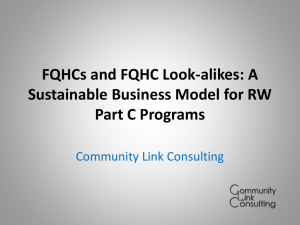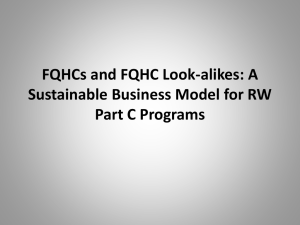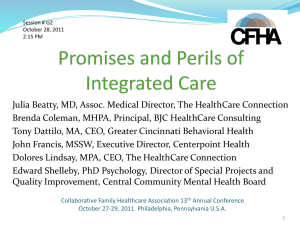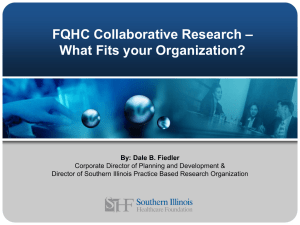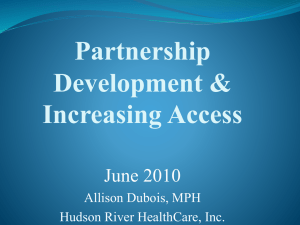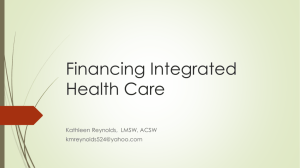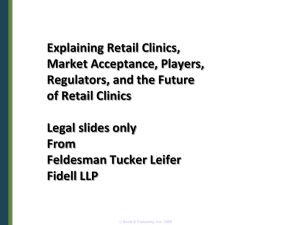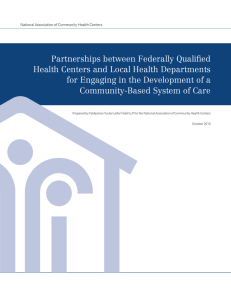Federally Qualified Health Centers
advertisement
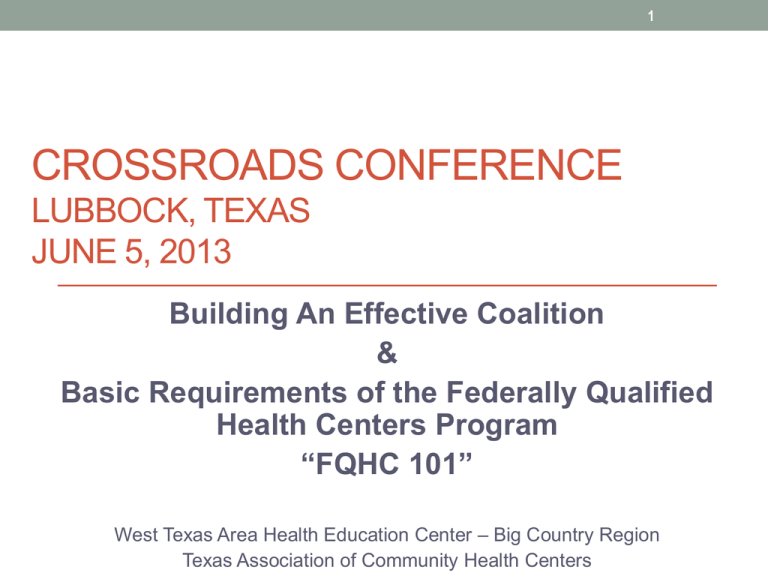
1 CROSSROADS CONFERENCE LUBBOCK, TEXAS JUNE 5, 2013 Building An Effective Coalition & Basic Requirements of the Federally Qualified Health Centers Program “FQHC 101” West Texas Area Health Education Center – Big Country Region Texas Association of Community Health Centers 2 Specific Problem Addressed Identify if there is a problem regarding access to care in Abilene 3 Steps to Create Our Coalition • AHEC – Responded to community need (neutral) • Recruiting the Right People • Formed the Coalition • Devise a Set of Preliminary Objectives/Activities • Process Begins 4 Who is Our Coalition? • Facilitator – AHEC Office • Representatives from the Hospitals • Mayor/Other City Officials • County Officials • Community Foundations/Leaders • Medical Society 5 Steps Taken with the Coalition • Additional Resources • Nonprofit Luncheon/Workshop • Data Collection • Physician Survey • Dental Survey • What did the data indicate? • Patterns • Strengths of Taylor County • Barriers to Care 6 Community Needs Assessment • Gaps in Health Services • Access to Care and Barriers to Care • Health Disparities of the Community 7 Service Provider Workshop • Primary Health Care • Dental Care • Medical Specialists • Mental Health Treatment 8 Primary Care Provider Survey Results • 30 Primary Care Providers Responded • 14 Accept Medicare • 16 Accept Medicaid • 14 Accept Uninsured Patients 9 Next Steps of the Coalition • Explore Expansion Opportunities with Existing Clinics • Establish a FQHC • Other 10 Topics of Discussion • FQHC characteristics • BPHC Section 330 program expectations/requirements • Benefits received from FQHC status • How FQHC addresses needs assessment components 11 Characteristics of a FQHC • Community based non-profit or public primary health care clinics • Located in or serving a designated Medically Underserved Area/Population (MUA or MUP) • Consumer Board governance structure • Provide health services to persons in all stages of the life cycle 12 Characteristics of a FQHC (cont’d) • Provide services to all persons regardless of ability to pay • Charge for services on a sliding-fee scale based on patients’ family income and size • Comply with Section 330 program expectations/requirements and all applicable federal and state regulations 13 Paths to Becoming a FQHC Collaborate with an existing FQHC to apply for HRSA New Access Point (NAP) grant Create new not-for-profit that will/does meet all program requirements to apply or HRSA NAP grant Extremely competitive grant application – less than 10% success rate Apply to be an FQHC Look-Alike (FQHCLA) Not-for-profit that meets all program requirements at the time of application No grant support when designated as a FQHCLA More competitive when applying for 330 funding 14 Section 330 Program Requirements • Four components: • Governance • Mission and Strategy • Clinical program • Management and finance 15 FQHC Governance • Board composition • Governed by community board • Non-consumer requirements • 9-25 members • By-laws prescribe method for selecting board members • Employees and relatives are ineligible 16 FQHC Governance • Board of Directors responsibilities • Carries legal and fiduciary responsibility for clinic • • • • • operations and grants Strategic planning and evaluation of progress toward organizational goals Approve Annual Budget & Grant Application Meet At Least Monthly / Keep Minutes Full authority over all aspects of clinic operations No other entity/individual can have the ability to override or veto governing board decisions 17 Mission and Strategy Mission: improve health status of underserved populations Strategy: Needs assessment - starting point but can be based on specific parameters in grant application guidance Design culturally and linguistically appropriate programs Measure effectiveness through health and financial outcomes Operate efficiently – maximize revenue and grow net assets Collaborate with other health care and social service providers 18 Why Demonstrating Need for FQHC is Important HRSA NAP guidance (HRSA 11-017) “Information provided on need should serve as the basis for, and align with, the proposed activities and goals described in the clinical and performance measures and throughout the application.” “Response” section of NAP application should propose activities that address health care and other needs in community 19 Clinical Program Provides a continuum of care Primary, secondary and tertiary Relies on collaboration with system providers to prevent duplication of services Service Delivery Model Must have direct control of majority of health care services Contracting Only to secure services not provided by center Written agreements are required Health Care Planning Develop goals to impact health care needs and monitor via health outcomes performance Clinical Staff Clinical Systems & Procedures Focus on electronic health and dental records implementation and meaningful use Others tied to operations and patient satisfaction 20 Required Services FQHC must provide directly or through written agreement • Primary care • Child and adult immunizations • Dental • Eye and ear screening for • Mental health • Substance Abuse • • Diagnostic lab and x-ray • • Prenatal and perinatal services • • Cancer and other disease • screening • Blood level screenings • • Lead levels • • • Communicable diseases • Cholesterol • Well child services • children Family planning services Emergency medical Pharmaceutical Case management Outreach and education Eligibility/Enrollment services Transportation and interpretation Referrals 21 Management and Finance Systems Systems must ensure that CEO and Board of Directors have access to timely information that is critical to sustainability MIS combines financial and utilization data for informed decision-making Implementation and meaningful use of electronic health/dental records Utilization is reported to federal authorities annually in the Uniform Data System report Financial system must provide for: Accounting and Internal controls Budget Billing and Collections Independent Financial Audit Facilities 22 Benefits of FQHC Status CENTER • Federal grants to support costs • • • • • of uncompensated care* Prospective Payment System reimbursement for services to Medicaid and Medicare patients Medical malpractice coverage under Federal Tort Claims Act * PHS Drug Pricing Discounts Grant support and loan guarantees for capital improvements Right to have outstationed eligibility workers on-site COMMUNITY Community-based organization Medical home for underserved Improved access to comprehensive health services Reduction of use of Emergency Rooms for non-emergent care Economic impact of federal and state investments Potential for additional federal investment *FQHC look-alikes do not get federal grant or FTCA coverage 23 Benefits of FQHC Status (cont’d) CENTER • Reimbursement by Medicare for “first dollar” of services (deductible is waived) • Access to Vaccines for Children (VFC) Program • Access to National Health Service Corps (NHSC) Placements • Closely align with definition of Essential Community Providers for participation in Health Insurance Exchanges COMMUNITY • Assistance with streamlined • • • • Medicaid and CHIP enrollment Less financial strain on Medicare patients Free immunizations for uninsured children Additional sources of primary care and other health providers Access to comprehensive primary care and additional services for newly insured 24 How FQHC Addresses Taylor County Needs Assessment Components • Required to serve Medically Underserved Area and target • • • • • • • services to persons under 200% of Federal Poverty Level Mission is to increase access to care for uninsured and underinsured Required to provide linguistically and culturally appropriate care History of reducing health disparities Dental and behavioral health services Eligibility assistance for public insurance Need for clinic that will accept uninsured, Medicaid, and Medicare Sliding fee discount for services 25 Contact Information Kelly Cheek Center Director West Texas Area Health Education Center Big Country Region 325-672-0495 kcheek@bcahec.org Daniel Diaz Director of Community Development Texas Association of Community Health Centers 512-329-5959 ddiaz@tachc.org

